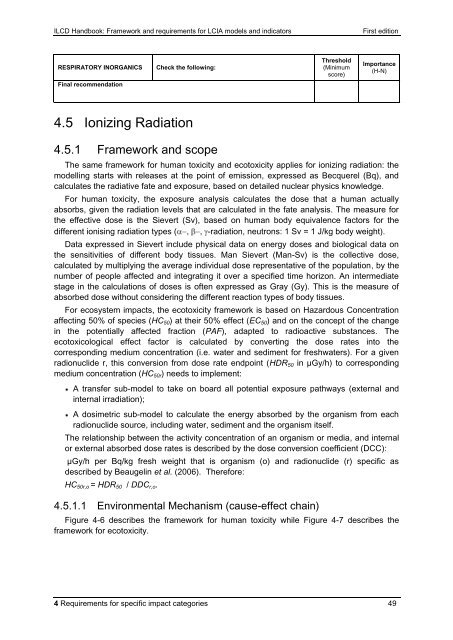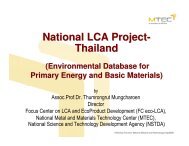ILCD Handbook: Framework and requirements for LCIA models and ...
ILCD Handbook: Framework and requirements for LCIA models and ...
ILCD Handbook: Framework and requirements for LCIA models and ...
You also want an ePaper? Increase the reach of your titles
YUMPU automatically turns print PDFs into web optimized ePapers that Google loves.
<strong>ILCD</strong> <strong>H<strong>and</strong>book</strong>: <strong>Framework</strong> <strong>and</strong> <strong>requirements</strong> <strong>for</strong> <strong>LCIA</strong> <strong>models</strong> <strong>and</strong> indicators First edition<br />
RESPIRATORY INORGANICS Check the following:<br />
Final recommendation<br />
4.5 Ionizing Radiation<br />
4.5.1 <strong>Framework</strong> <strong>and</strong> scope<br />
Threshold<br />
(Minimum<br />
score)<br />
Importance<br />
(H-N)<br />
The same framework <strong>for</strong> human toxicity <strong>and</strong> ecotoxicity applies <strong>for</strong> ionizing radiation: the<br />
modelling starts with releases at the point of emission, expressed as Becquerel (Bq), <strong>and</strong><br />
calculates the radiative fate <strong>and</strong> exposure, based on detailed nuclear physics knowledge.<br />
For human toxicity, the exposure analysis calculates the dose that a human actually<br />
absorbs, given the radiation levels that are calculated in the fate analysis. The measure <strong>for</strong><br />
the effective dose is the Sievert (Sv), based on human body equivalence factors <strong>for</strong> the<br />
different ionising radiation types ( -radiation, neutrons: 1 Sv = 1 J/kg body weight).<br />
Data expressed in Sievert include physical data on energy doses <strong>and</strong> biological data on<br />
the sensitivities of different body tissues. Man Sievert (Man-Sv) is the collective dose,<br />
calculated by multiplying the average individual dose representative of the population, by the<br />
number of people affected <strong>and</strong> integrating it over a specified time horizon. An intermediate<br />
stage in the calculations of doses is often expressed as Gray (Gy). This is the measure of<br />
absorbed dose without considering the different reaction types of body tissues.<br />
For ecosystem impacts, the ecotoxicity framework is based on Hazardous Concentration<br />
affecting 50% of species (HC50) at their 50% effect (EC50) <strong>and</strong> on the concept of the change<br />
in the potentially affected fraction (PAF), adapted to radioactive substances. The<br />
ecotoxicological effect factor is calculated by converting the dose rates into the<br />
corresponding medium concentration (i.e. water <strong>and</strong> sediment <strong>for</strong> freshwaters). For a given<br />
radionuclide r, this conversion from dose rate endpoint (HDR50 in µGy/h) to corresponding<br />
medium concentration (HC50r) needs to implement:<br />
A transfer sub-model to take on board all potential exposure pathways (external <strong>and</strong><br />
internal irradiation);<br />
A dosimetric sub-model to calculate the energy absorbed by the organism from each<br />
radionuclide source, including water, sediment <strong>and</strong> the organism itself.<br />
The relationship between the activity concentration of an organism or media, <strong>and</strong> internal<br />
or external absorbed dose rates is described by the dose conversion coefficient (DCC):<br />
µGy/h per Bq/kg fresh weight that is organism (o) <strong>and</strong> radionuclide (r) specific as<br />
described by Beaugelin et al. (2006). There<strong>for</strong>e:<br />
HC50r,o = HDR50 / DDCr,o.<br />
4.5.1.1 Environmental Mechanism (cause-effect chain)<br />
Figure 4-6 describes the framework <strong>for</strong> human toxicity while Figure 4-7 describes the<br />
framework <strong>for</strong> ecotoxicity.<br />
4 Requirements <strong>for</strong> specific impact categories 49



